In as far as there is a debate about the problems of cross border railways in Europe, one question crops up over and over: “why is there no Skyscanner for rail?” If one website can aggregate all the flights in Europe and allow a customer to compare prices and book them, why is there no proper equivalent for rail? (Omio, Trainline, NS International etc. are of course trying to solve this problem but are still a long way from really cracking it)
But before we even get to the issue of booking a train ticket, there is a more elementary problem – even finding out what trains run on cross border routes.
No complete European railway timetable exists, and that is a serious problem.
Please don’t say here “but what about the ex-Thomas Cook European Railway Timetable?” – sure, it’s a great publication, but it is based on the format of a paper timetable, and many trains relevant for cross border travel are not in it. In other words it is good, but not sufficient.
In this blog post I will examine how the absence of a European railway time is a problem in practice on two real cases – Osijek ?? – Pécs ?? and Bordeaux ?? – Donostia-San Sebastián ??
The closest there is to a digital European railway timetable is Deutsche Bahn’s Reiseauskunft. It’s the tool that even the venerable Man in Seat 61 recommends. That will be the tool we will use as the starting point in each case. And we will attempt both trips a fortnight from now – on Thursday 27th January, departing at about 8am in each case.
Case 1 – Osijek ?? – Pécs ??
Here Deutsche Bahn gives us just 1 daily connection, taking more than 16 hours!

If we look at the details of the connection it involves almost 10 hours in Koprivnica!
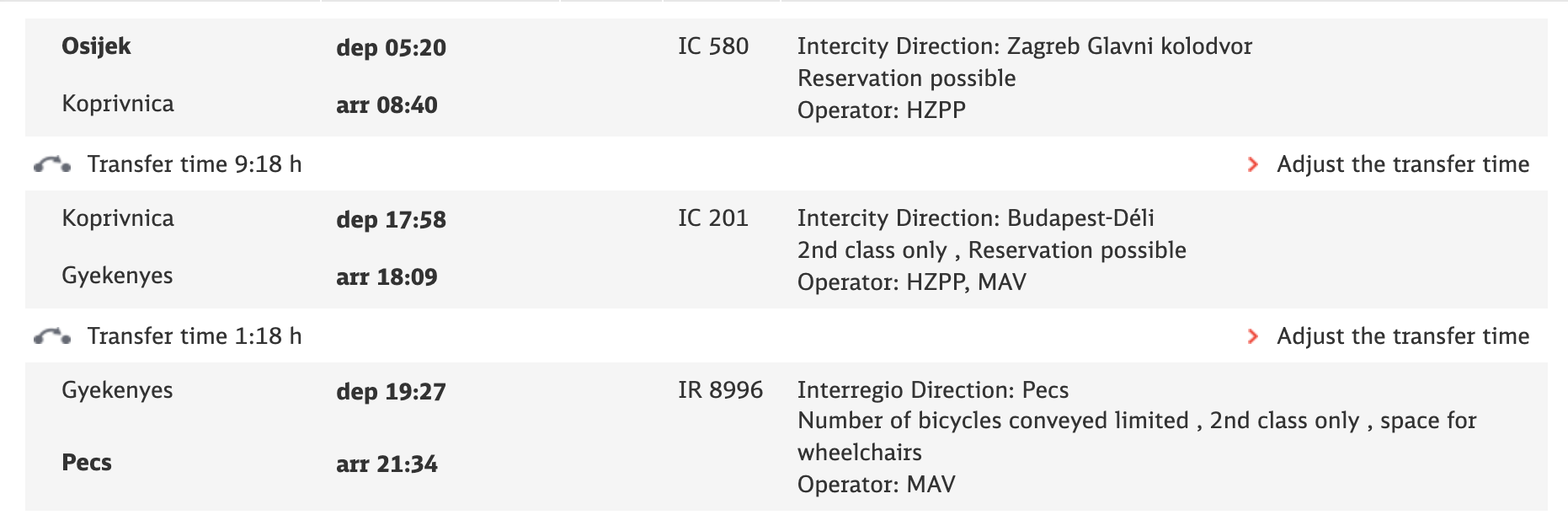
Also if we look at DB’s plot of the route we can also see the proposal is hardly logical. These cities are about 70km apart as the crow flies, and the shortest route by rail between them is 88.5km.
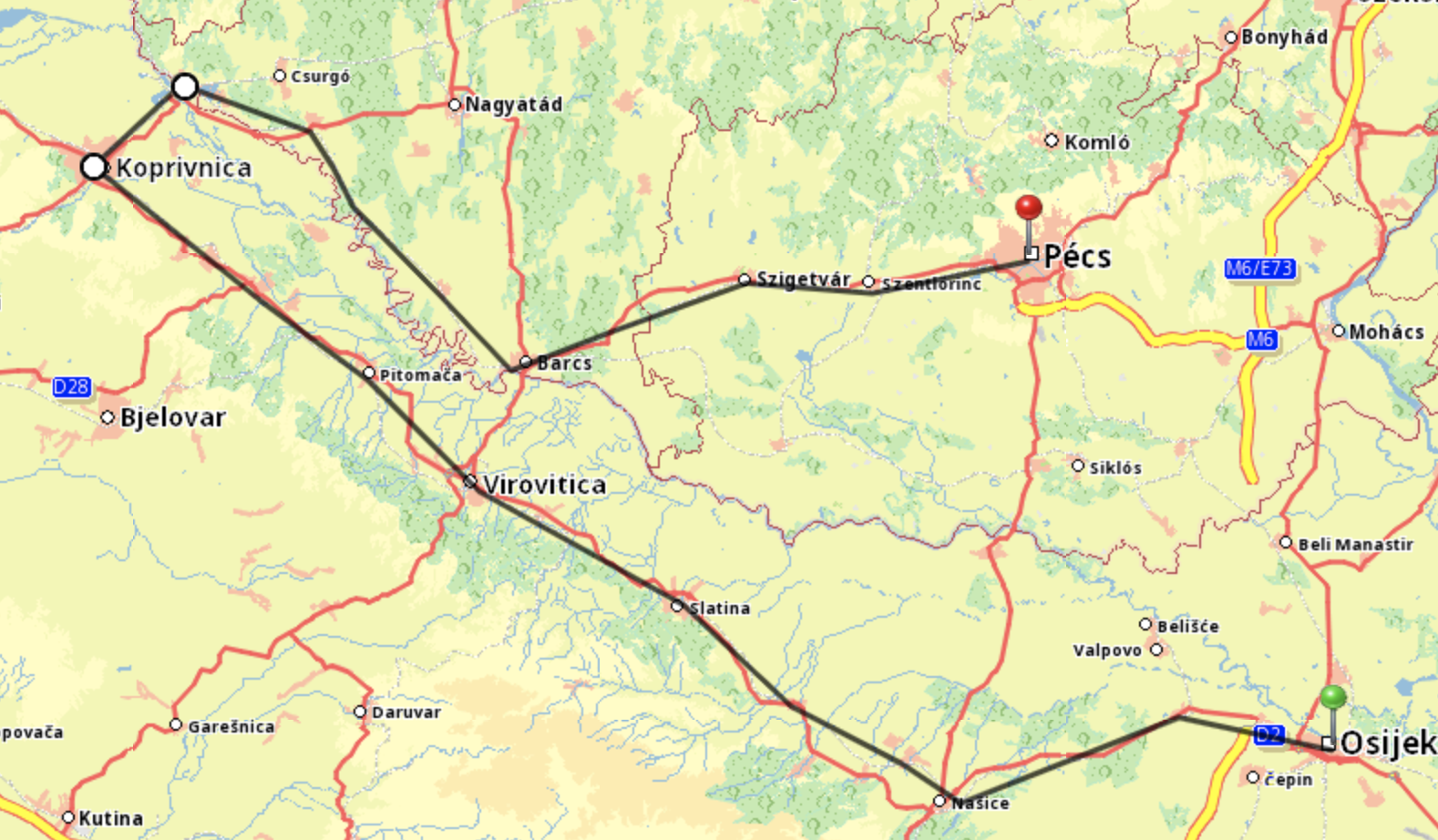
So let’s have a look at best railway map there is – Open Railway Map – and check out the area between Osijek and Pécs. Here is the relevant part – Pécs is at the top (PS), and Osijek bottom right. Orange lines are main lines, yellow-green is branch lines. The line runs through Beli Manastir, the only notable settlement closer to the border:

So what does Deutsche Bahn give us for each section?
Between Beli Manastir and Pécs there are trains:
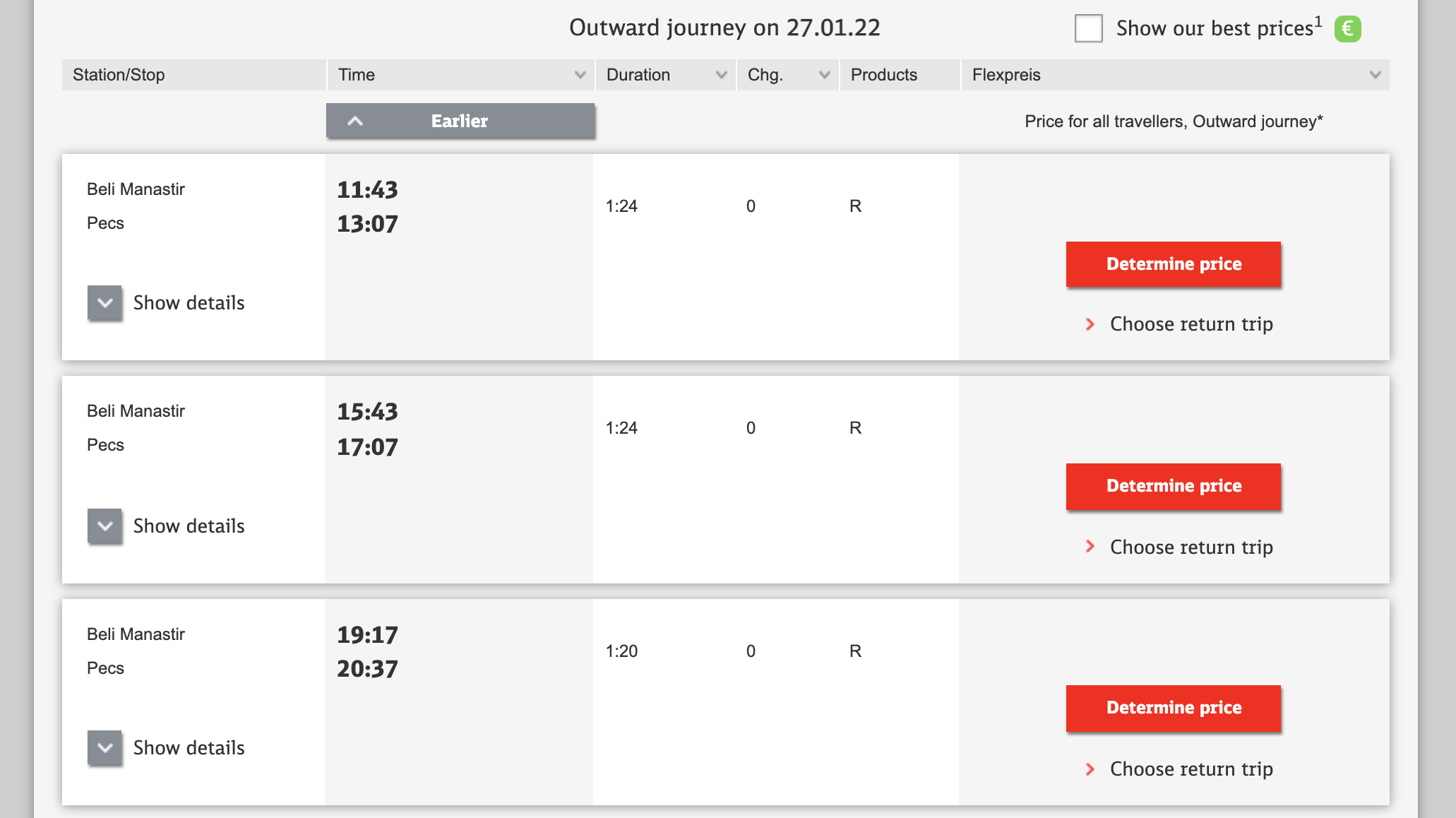
But DB finds nothing for Osijek – Beli Manastir – it gives an error:
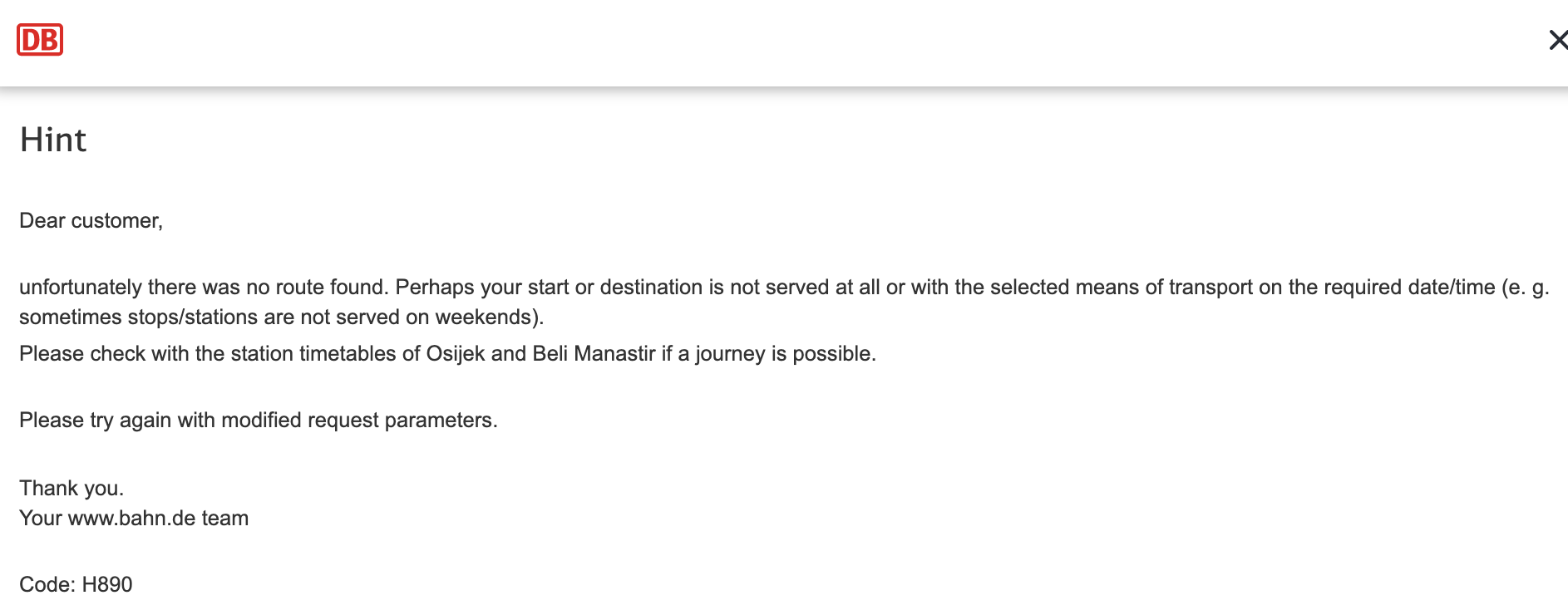
So let’s look at the website of HŽPP, the Croatian passenger railway operator. Bingo! There are trains!
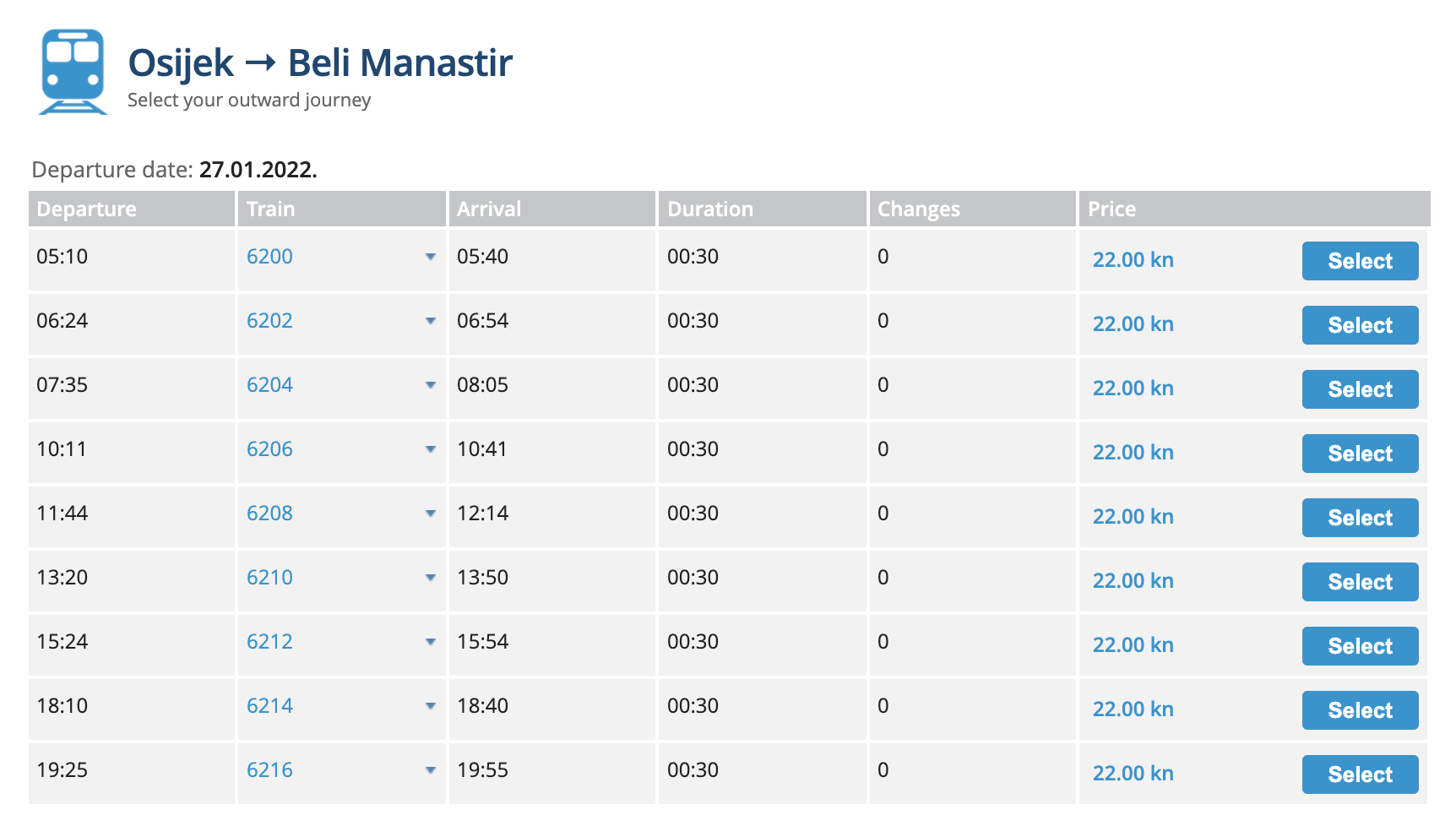
There would be a safe connection departing Osijek at 10:11, arriving Beli Manastir 10:41. Depart Beli Manastir at 11:43 and arrive Pécs at 13:07. Trip time: 2 hours 54 minutes (versus 16 hours 54 minutes proposed by DB!) and 1 change (better than the 2 with DB).
What is going on here?
Data on long distance trains in Croatia (InterCity services) are available in Deutsche Bahn’s site, while regional trains (like those that run on the Osijek – Beli Manastir route) are not – that data is only on the HŽPP site. On the Hungarian side it is different – Hungarian railway MÁV provide data on all of their trains for inclusion in Deutsche Bahn’s search. And to be absolutely sure we have it right can confirm these trains run on MÁV’s timetable tool (Schedule tab, not Buy Ticket tab).
The crux is this: trains do run between Osijek and Pécs, with a change in Beli Manastir. But the task to find an adequate connection is absurdly complicated (and beyond the ability of most non-locals) – because no complete European railway timetable exists.
Case 2 – Bordeaux ?? – Donostia-San Sebastián ??
Put this one into Deutsche Bahn’s search and you get… no result!

So off we go to Open Railway Map (only the cross border part shown):
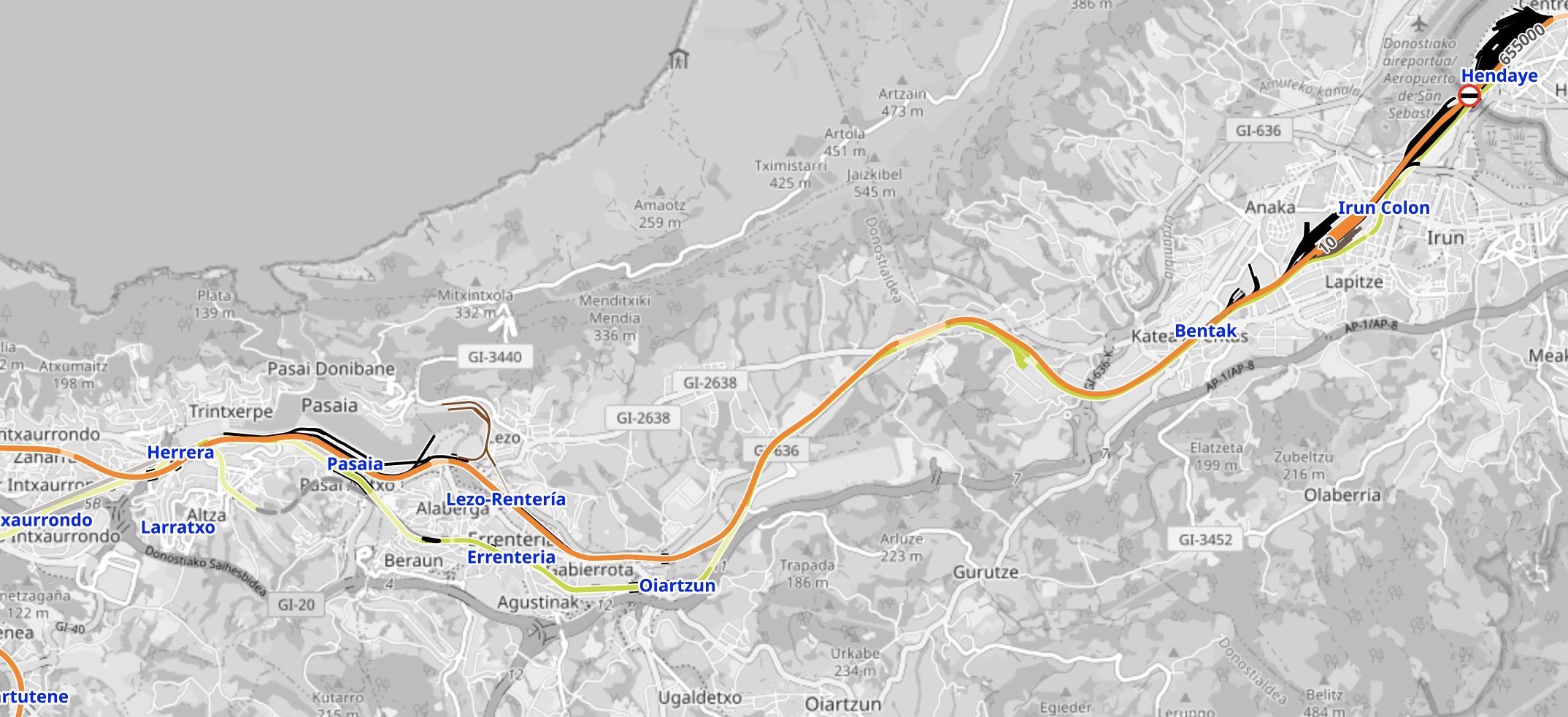
There are through lines between Hendaye (France) and Irún (Spain).
Deutsche Bahn can find us trains – regional services and TGVs – between Bordeaux and Hendaye – this looks OK:
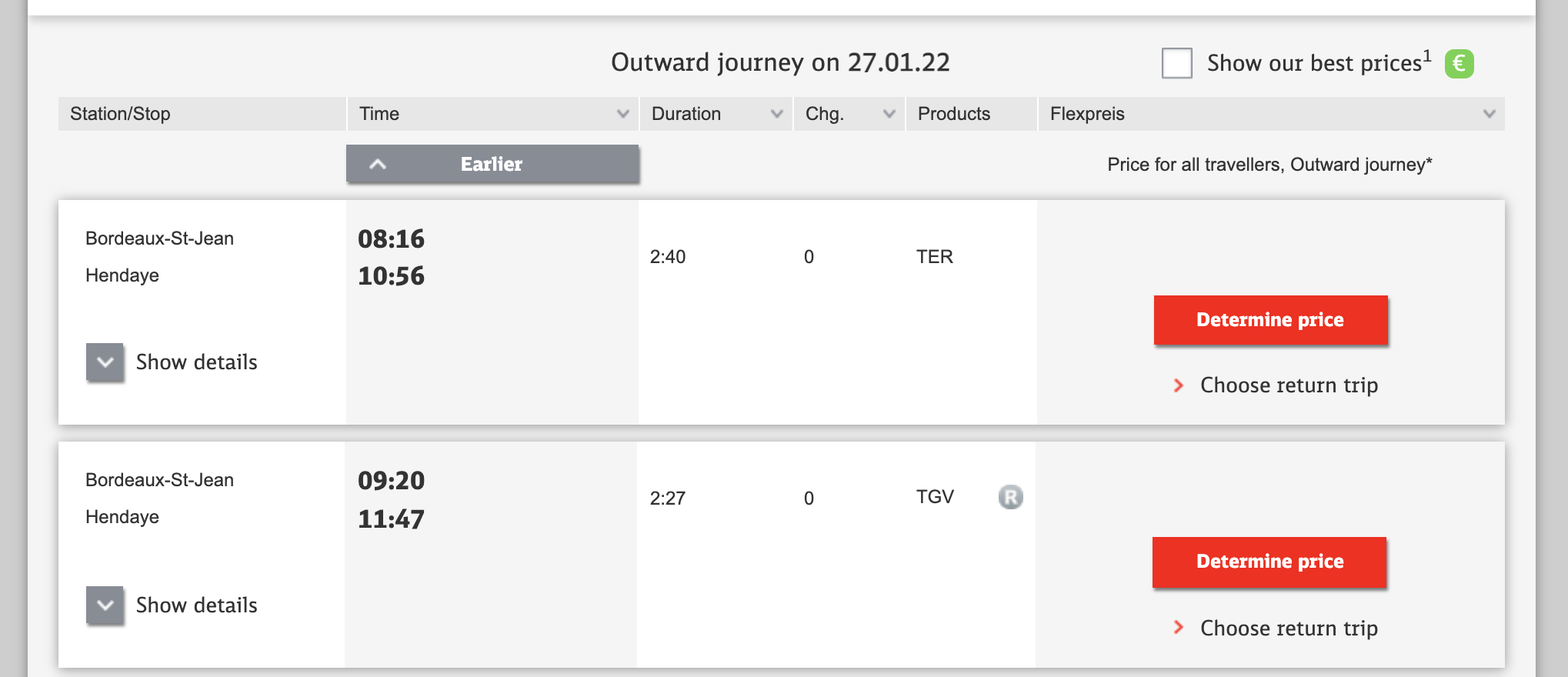
And a few trains between Irún and San Sebastian:
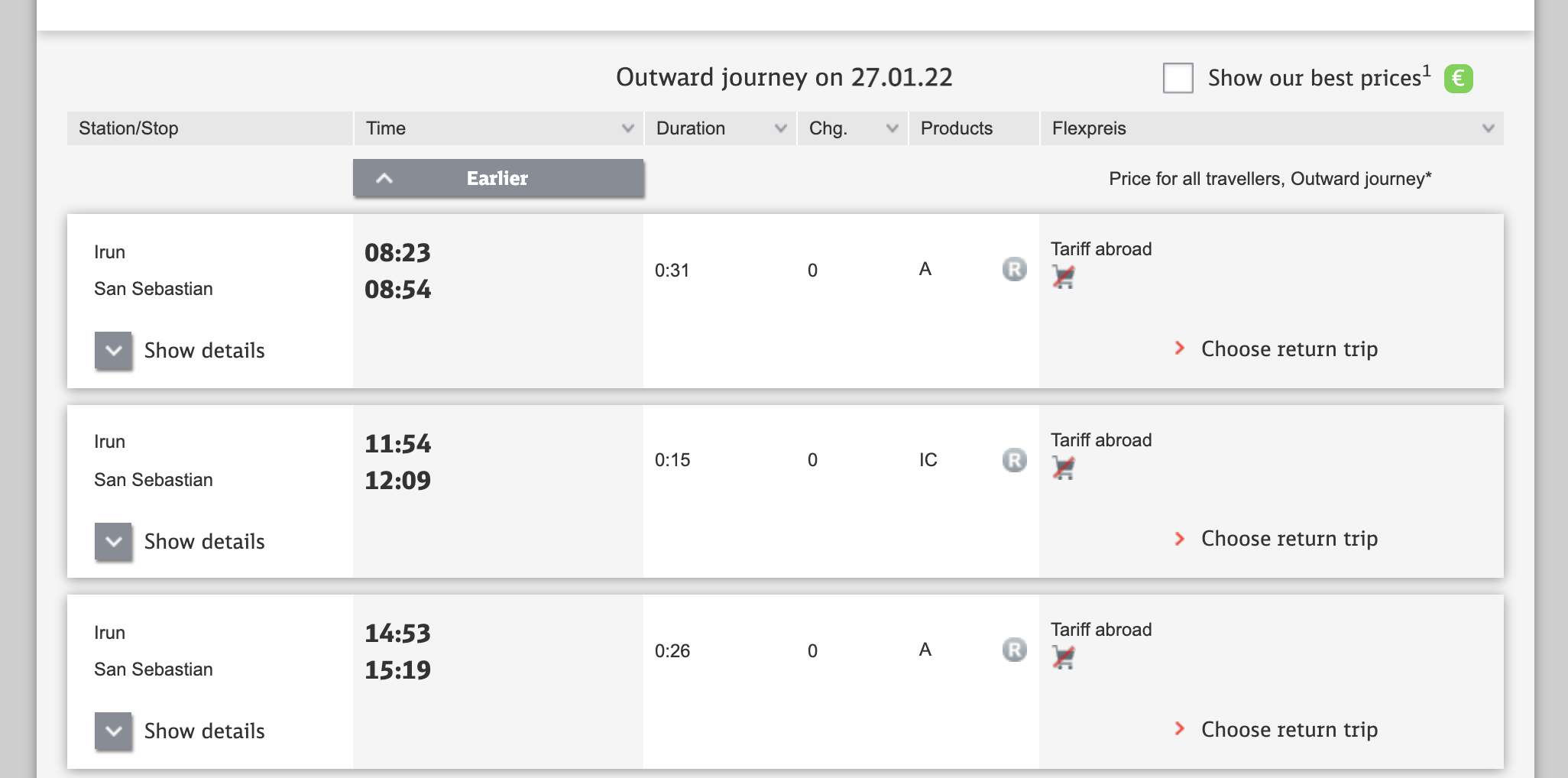
So Deutsche Bahn does not show anything the short cross-border section between Hendaye and Irún.
But what about the lime green line on the Open Railway Map excerpt above? That’s a Euskotren Trena line. And Euskotren data – despite the services being publicly owned and run – is not available from DB. But there is a train every 30 minutes from Hendaye (Hendaia) to Amara-Donostia, the main terminus in Donostia-San Sebastián – full timetable here:
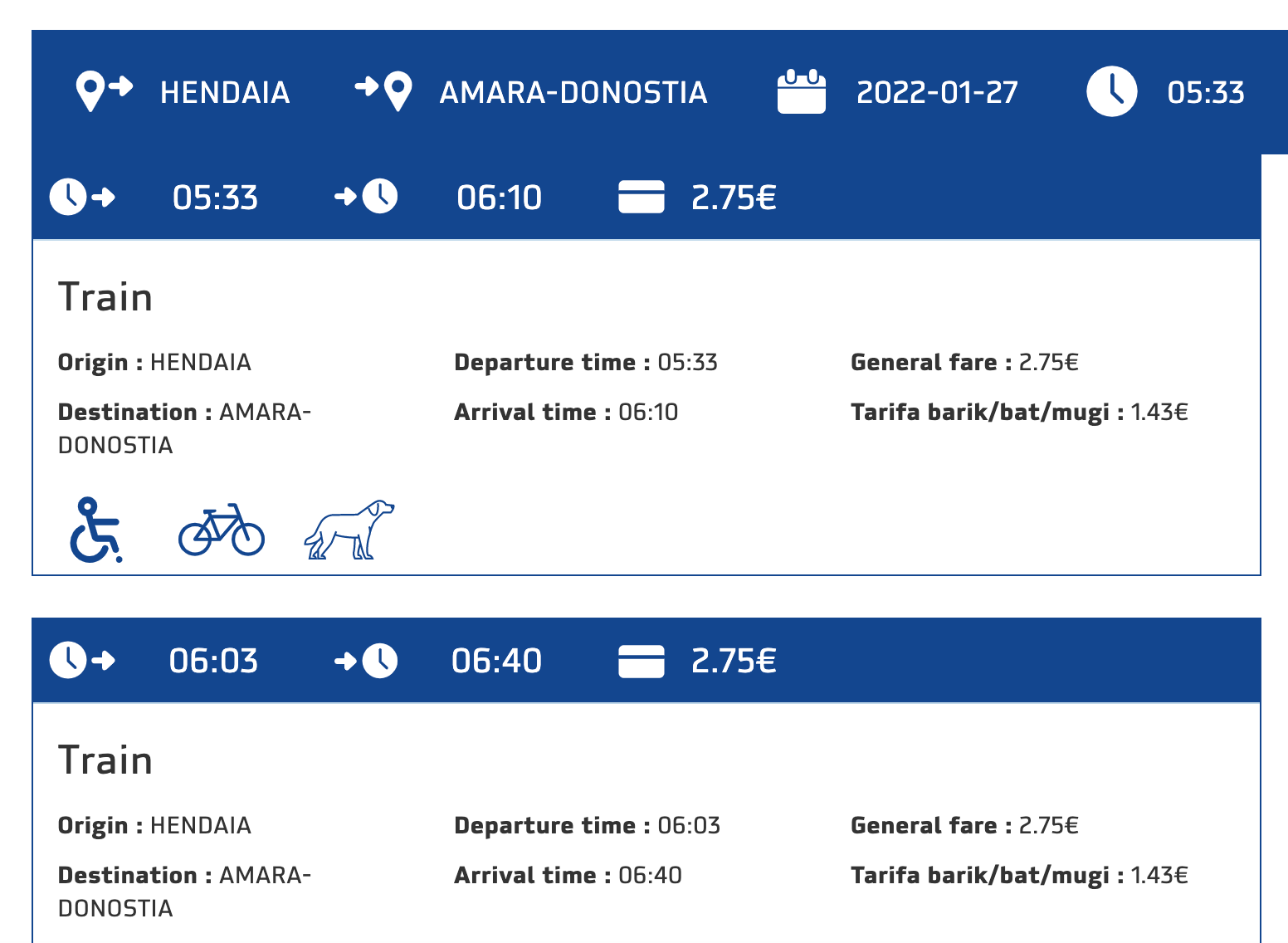
So that way it is possible to complete the Bordeaux – Donostia-San Sebastián as follows: Depart Bordeaux at 08:23, Arrive Hendaye at 10:56. Depart Hendays on Euskotren Trena at 11:03 and arrive at 11:40. Trip time: 3 hours 17 minutes, 1 change.
But we’re not quite done… Deutsche Bahn shows only very few trains between Irún and San Sebastián. That’s because Deutsche Bahn does not show the local Cercanías trains (these run on regular lines, so are separate from Euskotren, but stop at all stations) in its search either. To find these you need to use this search. While long distance trains in Spain are in this search. In other words there is not even a proper and complete timetable within Spain. There is also the ridiculous issue that Cercanías trains run only to Irún, when they could run as far as Hendaye to connect with French trains (and SNCF trains could likewise run to Irún) – but that’s an issue of lack of services, and this blog post is about timetables.
So in this case as well, the cross border train service is comparatively good – a train every 30 minutes – but trying to find out what runs, and how services connect together, is unnecessarily complex.
To conclude, as I hope these two cases have shown, before we begin to really be able to build a Skyscanner for Rail in Europe, we need a solid European digital timetable that reliably has all trains in it. Until we do, cross border rail is destined to suffer. And the infuriating thing in both these cases is that the cross border service – the trains themselves – is quite reasonable, and that should be the complex bit! But information provision – that should be the easier bit – is what’s lacking.
Photo Rights
Photo of the MÁV train at Beli Manastir, by @larsvr06 on Twitter, used with permission














Hi Jon,
this never ending issue was the inspiration for my bachelor dissertation back in 2014/2015 to build a software that would plan such trans-border journeys including not just rail but also air and bus connections. Your examples are very easy (I know that the point is to show the absurd situation on the simple journeys, let alone more complex journeys). The biggest pain in my case was to actually find the data sources and the best transitional places, where it makes the most sense to query the system of the other transport company/authority. What I mean by that is that depending on your journey, a different place to make the change from one system to the other might make more sense.
For example, you could make a query for a journey from someone in Belgium to Aachen Hbf on the SNCB/NMBS website and from there using the Deutsche Bahn system for the German lag.
Another solution could be to run a query from somewhere in Belgium to Hergenrath (last station in Belgium) on SNCB/NMBS and from there using DB.
Yet another one could involve querying the SNCB/NMBS or TEC system to the last bus stop in Belgium and from there query the AVV system for the remainder of the journey.
(Of course there are many more combinations that could be tried out.)
The journey planning results from Deutsche Bahn are good but the problem is the data that is sent to the European Timetable Centre (Europäisches Fahrplanzentrum is the key phrase for any search). That data is highly dependent on the each railway company and quite few of them send in just a selection of the trains and it is not rare that the data only gets updated twice a year (timetable change in second December weekend and around May) and any changes that appear afterwards (e.g. due to maintenance work) are not communicated there. Also, in some countries the timetable becomes final at very short notice. For example, in Poland it is just three weeks, where as in the UK it is around 10 weeks. This is the root of the problem. If all rail operators would send in full data and keep it up-to-date, this problem would be solved.
I wonder if it would be feasible for UIC to open up input access to the database to volunteers selected using some suitable criteria? I mean, surely there must be enough volunteers, for instance among your followers on social media, that would gladly spend some hours a year on typing in timetable information collected from authoritative sources… And then other volunteers would double-check the correctness of the all entered data. Sure, such volunteer-provided data would probably need to be flagged somehow to make consumers of the data aware that it is not authoritative.
Just consider how well OpenStreetMap works. I assume many local government agencies see no huge risk in displaying OpenStreetMap data in their transit maps. (I know at least the Helsinki Regional Transit authority does, https://wiki.openstreetmap.org/wiki/Helsinki_Region_Transport )
But yeah, I have no idea how UIC works and how resistent to change its processes are.
Based on my communication with UIC: not a hope. Anyone outside a railway firm seems to be a threat!
I wonder very much: why is it not easy to fix this with an EU law oblidging all train companies operating in Europe to provide the current and known upcoming schedules as machine readable data publicly? It cannot be a business secret what is already on their own public homepages.
Hi Jon,
Why do you use Deutsche Bahn’s Reiseauskunft as reference? It is a railway undertaking’s ticketing site. It was never intended to be a timetable service.
Czechia has a timetable service, IDOS.cz. It is part of the infrastructure, belongs to the Czech Ministry of Transport. It is multimodal (trains, busses, trams, metro, municipal ferries): Operators of regular passenger services are legally obliged to supply their timetables in computer readable form for entry into the database (in a timely manner, with deadlines and penalties). The transport undertakings are also encouraged to supply realtime information about delays.
The IDOS search engine combines all this information to show routes from A to B. If you enter an address in a city, it picks the closest bus/tram/train stops. If a train (or whatever) is delayed, it will look for alternative routes. “Advanced search” offers filters and options for needs ♿ and nerds.
The service is cost-neutral for the state, financed by advertising on the website. AFAIK it makes profit, proving that “timetable as a service” is commercially viable.
The IDOS operators have added timetables from other countries, where easily available, but there is no guarantee for completeness: What is missing is the legal framework that forces the stakeholders to supply their timetables in computer readable form and to keep them updated. Simply copy the Czech legislation, and the problem is solved!
For details, read my post (in German) on Drehscheibe-Online.de (after clicking thru the legal disclaimer), or contact the company that operates the database on behalf of the Ministry, CHAPS.cz.
I don’t use IDOS for international planning… because – whatever the ethics of it – it’s not actually very good at that.
It can’t even plot me a rail route from Berlin to Stockholm.
In terms of giving me a decent route, DB Reiseauskunft (and SBB, and ÖBB Scotty) are still a lot better, although a long way from perfect.